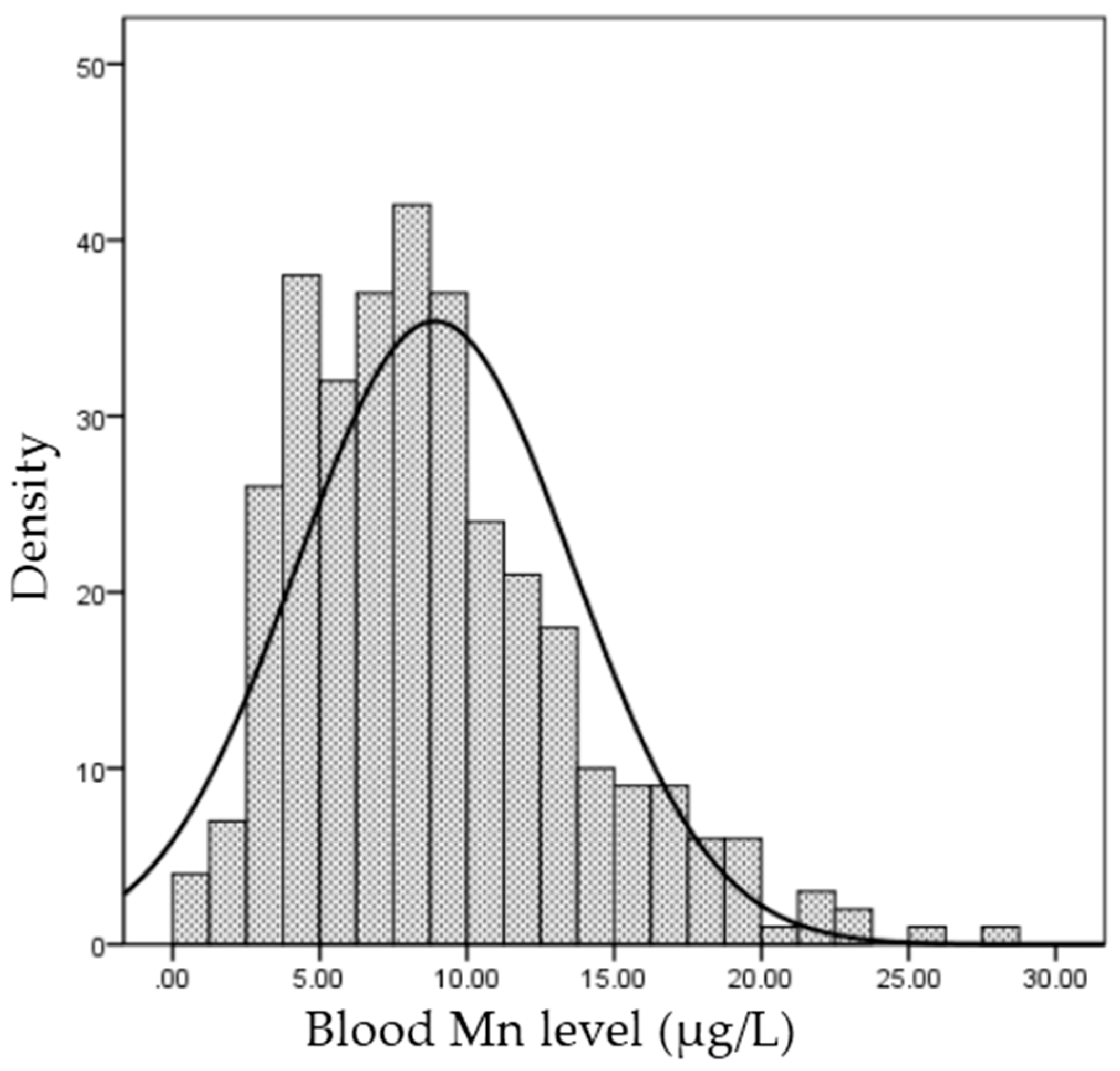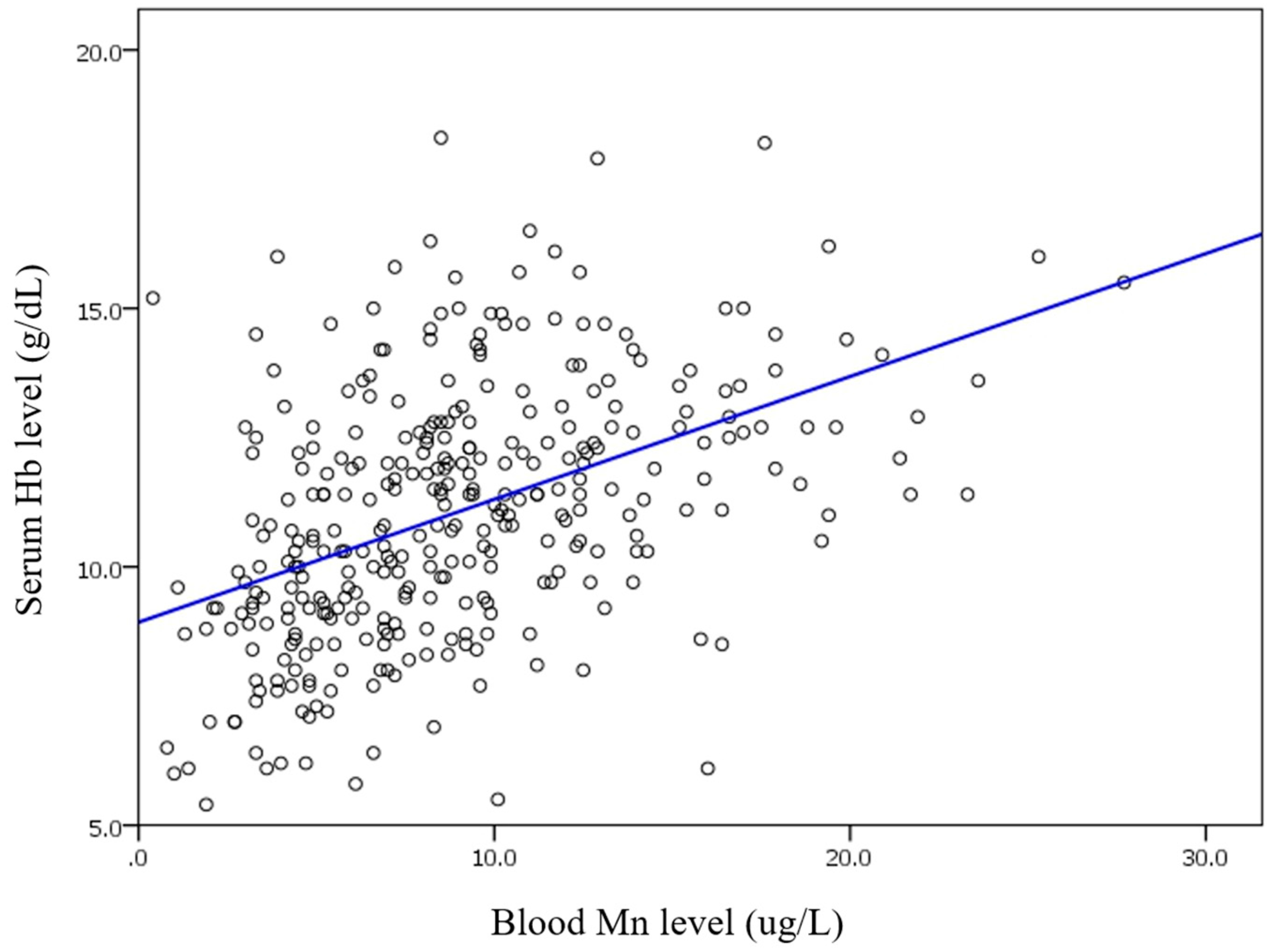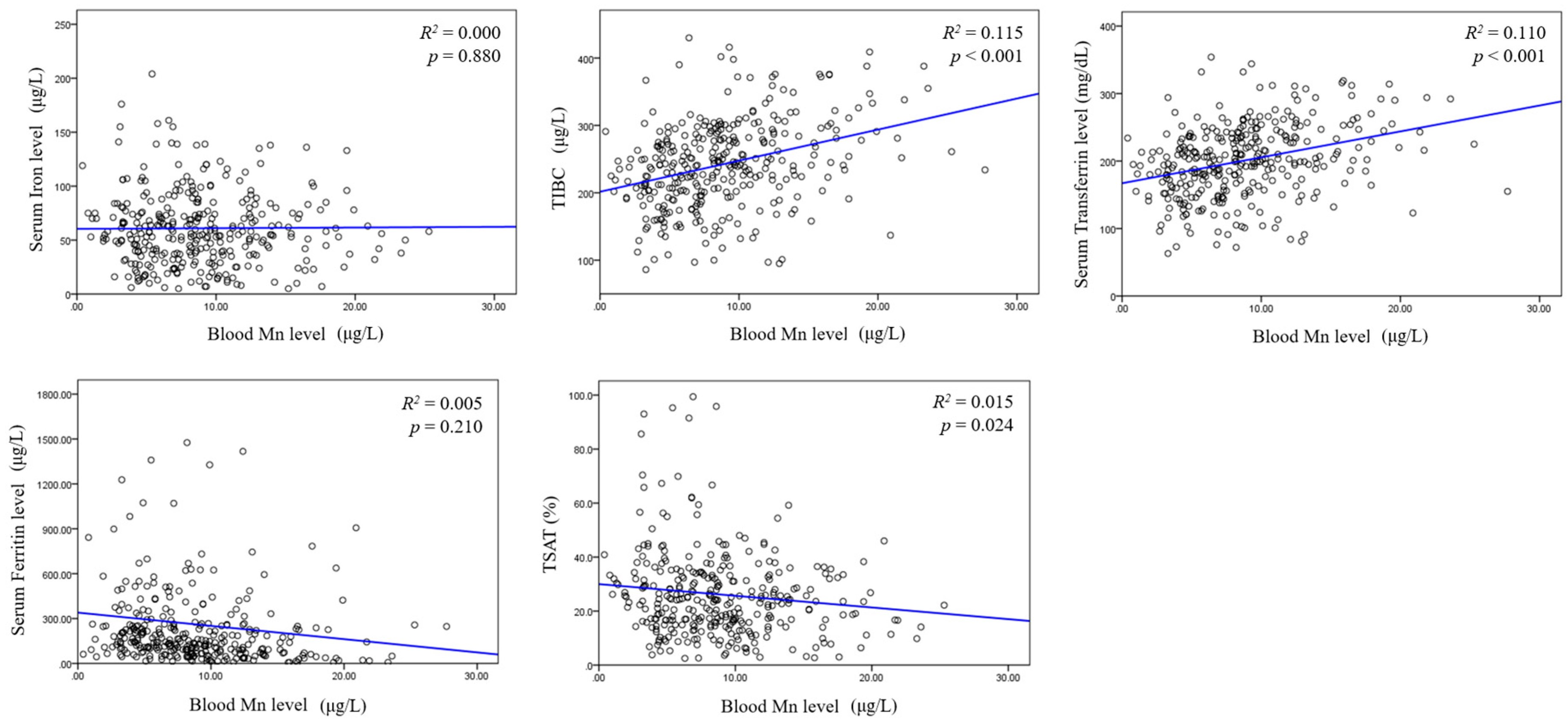Altered Metabolism of Blood Manganese Is Associated with Low Levels of Hemoglobin in Patients with Chronic Kidney Disease
Abstract
:1. Introduction
2. Materials and Methods
2.1. Definitions
2.2. Laboratory Measurements
2.3. Statistical Analyses
3. Results
3.1. Basal Characteristics and Distribution of Blood Mn Level
3.2. Determinants of Blood Mn Level
3.3. Linear Association of Blood Mn Level and Anemia Markers
3.4. Poisson Regression Analysis with Robust Variance between Anemia and Blood Mn and Clinical and Nutritional Factors
3.5. Prevalence Ratio (PR) and 95% Confidence Interval (CI) Values for Anemia with Blood Mn (μg/L) in Subgroups
4. Discussion
5. Conclusions
Acknowledgments
Author Contributions
Conflicts of Interest
References
- Malecki, E.A.; Huttner, D.L.; Greger, J. Manganese status, gut endogenous losses of manganese, and antioxidant enzyme activity in rats fed varying levels of manganese and fat. Biol. Trace Elem. Res. 1994, 42, 17–29. [Google Scholar] [CrossRef] [PubMed]
- Aschner, J.L.; Aschner, M. Nutritional aspects of manganese homeostasis. Mol. Asp. Med. 2005, 26, 353–362. [Google Scholar] [CrossRef] [PubMed]
- Parmalee, N.L.; Aschner, M. Manganese and aging. Neurotoxicology 2016, 56, 262–268. [Google Scholar] [CrossRef] [PubMed]
- Chung, S.; Koh, E.S.; Shin, S.J.; Park, C.W. Malnutrition in patients with chronic kidney disease. OJIM 2012, 2, 89–99. [Google Scholar] [CrossRef]
- Krachler, M.; Wirnsberger, G.; Irgolic, K.J. Trace element status of hemodialyzed patients. Biol. Trace Elem. Res. 1997, 58, 209–221. [Google Scholar] [CrossRef] [PubMed]
- Rucker, D.; Thadhani, R.; Tonelli, M. Trace element status in hemodialysis patients. Semin. Dial. 2010, 23, 389–395. [Google Scholar] [CrossRef] [PubMed]
- Koh, E.S.; Kim, S.J.; Yoon, H.E.; Chung, J.H.; Chung, S.; Park, C.W.; Chang, Y.S.; Shin, S.J. Association of blood manganese level with diabetes and renal dysfunction: A cross-sectional study of the Korean general population. BMC Endocr. Disord. 2014, 14, 24. [Google Scholar] [CrossRef] [PubMed]
- Sanchez-Gonzalez, C.; Lopez-Chaves, C.; Gomez-Aracena, J.; Galindo, P.; Aranda, P.; Llopis, J. Association of plasma manganese levels with chronic renal failure. J. Trace Elem. Med. Biol. 2015, 31, 78–84. [Google Scholar] [CrossRef] [PubMed]
- Fitsanakis, V.A.; Zhang, N.; Garcia, S.; Aschner, M. Manganese (Mn) and iron (Fe): Interdependency of transport and regulation. Neurotox. Res. 2010, 18, 124–131. [Google Scholar] [CrossRef] [PubMed]
- Rahman, M.A.; Rahman, B.; Ahmed, N. High blood manganese in iron-deficient children in Karachi. Public Health Nutr. 2013, 16, 1677–1683. [Google Scholar] [CrossRef] [PubMed]
- Levey, A.S.; Coresh, J.; Greene, T.; Stevens, L.A.; Zhang, Y.L.; Hendriksen, S.; Kusek, J.W.; Van Lente, F. Using standardized serum creatinine values in the modification of diet in renal disease study equation for estimating glomerular filtration rate. Ann. Int. Med. 2006, 145, 247–254. [Google Scholar] [CrossRef] [PubMed]
- Kasper, D.L.; Fauci, A.S.; Hauser, S.L.; Longo, D.L.; Jameson, J.L.; Loscalzo, J. Anemia and polycythemia. In Harrison’s Manual of Medicine, 19th ed.; McGraw-Hill Education: New York, NY, USA, 2016. [Google Scholar]
- Mena, I.; Horiuchi, K.; Burke, K.; Cotzias, G. Chronic manganese poisoning individual susceptibility and absorption of iron. Neurology 1969, 19, 1000–1006. [Google Scholar] [CrossRef] [PubMed]
- Park, S.; Sim, C.S.; Lee, H.; Kim, Y. Blood manganese concentration is elevated in infants with iron deficiency. Biol. Trace Elem. Res. 2013, 155, 184–189. [Google Scholar] [CrossRef] [PubMed]
- Kim, Y.; Lee, B.K. Iron deficiency increases blood manganese level in the Korean general population according to knhanes 2008. Neurotoxicology 2011, 32, 247–254. [Google Scholar] [CrossRef] [PubMed]
- Finley, J.W. Manganese absorption and retention by young women is associated with serum ferritin concentration. Am. J. Clin. Nutr. 1999, 70, 37–43. [Google Scholar] [PubMed]
- Finley, J.W.; Johnson, P.E.; Johnson, L. Sex affects manganese absorption and retention by humans from a diet adequate in manganese. Am. J. Clin. Nutr. 1994, 60, 949–955. [Google Scholar] [PubMed]
- Brna, P.; Gordon, K.; Dooley, J.M.; Price, V. Manganese toxicity in a child with iron deficiency and polycythemia. J. Child Neurol. 2011, 26, 891–894. [Google Scholar] [CrossRef] [PubMed]
- Smith, E.A.; Newland, P.; Bestwick, K.G.; Ahmed, N. Increased whole blood manganese concentrations observed in children with iron deficiency anaemia. J. Trace Elem. Med. Biol. 2013, 27, 65–69. [Google Scholar] [CrossRef] [PubMed]
- Flanagan, P.R.; Haist, J.; Valberg, L.S. Comparative effects of iron deficiency induced by bleeding and a low-iron diet on the intestinal absorptive interactions of iron, cobalt, manganese, zinc, lead and cadmium. J. Nutr. 1980, 110, 1754–1763. [Google Scholar] [PubMed]
- Tonelli, M.; Wiebe, N.; Hemmelgarn, B.; Klarenbach, S.; Field, C.; Manns, B.; Thadhani, R.; Gill, J. Trace elements in hemodialysis patients: A systematic review and meta-analysis. BMC Med. 2009, 7, 25. [Google Scholar] [CrossRef] [PubMed] [Green Version]
- Longo, D.L.; Fauci, A.S.; Kasper, D.L.; Hauser, S.L.; Jameson, J.L.; Loscalzo, J. Red blood cell disorders. In Harrison’s Manual of Medicine, 19th ed.; McGraw-Hill Education: New York, NY, USA, 2016. [Google Scholar]
- Brugnara, C. Iron deficiency and erythropoiesis: New diagnostic approaches. Clin. Chem. 2003, 49, 1573–1578. [Google Scholar] [PubMed]
- Babitt, J.L.; Lin, H.Y. Mechanisms of anemia in ckd. J. Am. Soc. Nephrol. 2012, 23, 1631–1634. [Google Scholar] [CrossRef] [PubMed]
- Larson, D.S.; Coyne, D.W. Understanding and exploiting hepcidin as an indicator of anemia due to chronic kidney disease. Kidney Res. Clin. Pract. 2013, 32, 11–15. [Google Scholar] [CrossRef] [PubMed]
- Rossi, E. Hepcidin-the iron regulatory hormone. Clin. Biochem. Rev. 2005, 26, 47. [Google Scholar] [PubMed]
- Mena, N.P.; Esparza, A.L.; Núñez, M.T. Regulation of transepithelial transport of iron by hepcidin. Biol. Res. 2006, 39, 191–193. [Google Scholar] [CrossRef] [PubMed]
- Mena, N.P.; Esparza, A.; Tapia, V.; Valdés, P.; Nunez, M.T. Hepcidin inhibits apical iron uptake in intestinal cells. Am. J. Physiol. 2008, 294, G192–G198. [Google Scholar] [CrossRef] [PubMed]
- Nemeth, E.; Tuttle, M.S.; Powelson, J.; Vaughn, M.B.; Donovan, A.; Ward, D.M.; Ganz, T.; Kaplan, J. Hepcidin regulates cellular iron efflux by binding to ferroportin and inducing its internalization. Science 2004, 306, 2090–2093. [Google Scholar] [CrossRef] [PubMed]
- De Domenico, I.; Ward, D.M.; Langelier, C.; Vaughn, M.B.; Nemeth, E.; Sundquist, W.I.; Ganz, T.; Musci, G.; Kaplan, J. The molecular mechanism of hepcidin-mediated ferroportin down-regulation. Mol. Biol. Cell 2007, 18, 2569–2578. [Google Scholar] [CrossRef] [PubMed]
- Babitt, J.L.; Lin, H.Y. Molecular mechanisms of hepcidin regulation: Implications for the anemia of ckd. Am. J. Kidney Dis. 2010, 55, 726–741. [Google Scholar] [CrossRef] [PubMed]
- Jouihan, H.A.; Cobine, P.A.; Cooksey, R.C.; Hoagland, E.A.; Boudina, S.; Abel, E.D.; Winge, D.R.; McClain, D.A. Iron-mediated inhibition of mitochondrial manganese uptake mediates mitochondrial dysfunction in a mouse model of hemochromatosis. Mol. Med. 2008, 14, 98–108. [Google Scholar] [CrossRef] [PubMed]
- Anand, N.; Chandrasekaran, S.; Alam, M.N. The malnutrition inflammation complex syndrome-the micsing factor in the perio-chronic kidney disease interlink. J. Clin. Diagn. Res. 2013, 7, 763. [Google Scholar] [CrossRef] [PubMed]
- Kovesdy, C.P.; Kopple, J.D.; Kalantar-Zadeh, K. Management of protein-energy wasting in non-dialysis-dependent chronic kidney disease: Reconciling low protein intake with nutritional therapy. Am. J. Clin. Nutr. 2013, 97, 1163–1177. [Google Scholar] [CrossRef] [PubMed]
- Zhang, K.; Gao, J.; Chen, J.; Liu, X.; Cai, Q.; Liu, P.; Huang, H. Mics, an easily ignored contributor to arterial calcification in ckd patients. Am. J. Physiol. 2016, 311, F663–F670. [Google Scholar] [CrossRef] [PubMed]
- Li, C.; Zhou, H.-M. The role of manganese superoxide dismutase in inflammation defense. Enzyme Res. 2011, 2011, 387176. [Google Scholar] [CrossRef] [PubMed]
- Malecki, E.; Greger, J. Manganese protects against heart mitochondrial lipid peroxidation in rats fed high concentrations of dietary polyunsaturated fatty acids. J. Nutr. 1996, 125, 27–33. [Google Scholar]




| Characteristic | Total (n = 334) |
|---|---|
| Male, n (%) | 159 (47.60) |
| Age | 60.49 ± 19.36 |
| BMI (kg/m2) | 24.05 ± 4.52 |
| Smoking, n (%) | 78 (23.35) |
| Hypertension, n (%) | 211 (63.17) |
| DM, n (%) | 135 (40.42) |
| Coronary artery disease, n (%) | 35 (10.47) |
| PAD, n (%) | 2 (0.59) |
| Chronic HF, n (%) | 17 (5.08) |
| Cerebrovascular disease, n (%) | 43 (12.87) |
| BUN (mg/dL) | 33.60 (15.47–69.43) |
| Cr (mg/dL) | 1.83 (0.85–4.37) |
| eGFR (mL/min/1.73 m2) | 34.35 (12.50–82.07) |
| CKD Stage 1 (eGFR ≥ 90) | 75(22.45) |
| CKD stage 2 (60 ≤ eGFR ≤ 89) | 53(15.87) |
| CKD stage 3 (30 ≤ eGFR ≤ 59) | 50(14.97) |
| CKD stage 4 (15 ≤ eGFR ≤ 30) | 53(15.87) |
| CKD stage 5 (eGFR < 15) | 103(30.84) |
| Serum total protein (g/dL) | 6.50 (5.80–7.10) |
| Serum albumin (g/dL) | 3.63 (3.13–4.09) |
| Blood Manganese (μg/L) | 8.30 (5.27–11.63) |
| Total cholesterol (μg/L) | 157.0 (129.0–200.00) |
| Anemia, n (%) | 233 (69.76) |
| Hb (g/dL) | 11.00 (9.2–12.7) |
| Hct (%) | 32.08 (27.25–36.70) |
| RDW (%) | 13.40 (12.60–14.50) |
| Iron (μg/dL) | 56.00 (37.0–77.0) |
| Ferritin (ng/mL) | 141.08 (70.88–254.91) |
| TIBC (μg/dL) | 241.00 (202.0–284.0) |
| Transferrin (mg/dL) | 202.00 (164.0–236.0) |
| TSAT (%) | 24.0 (15.50–33.30) |
| Erythropoietin stimulating agent, n (%) | 44 (13.17) |
| Iron supplement, n (%) | 33 (9.88) |
| Linear Regression Model | Unadjusted | Adjusted Multivariate | ||
|---|---|---|---|---|
| β | p Value | β | p Value | |
| Gender, female | 0.854 | 0.098 | 1.004 | 0.072 |
| Age, per 1 year | −0.049 | <0.001 | 0.017 | 0.326 |
| BMI, per 1 kg/m2 | 0.002 | 0.975 | −0.067 | 0.229 |
| Smoking | −1.588 | 0.009 | 2.069 | 0.001 |
| Hypertension | −1.470 | 0.006 | 0.758 | 0.230 |
| DM | 0.925 | 0.078 | −1.453 | 0.012 |
| Anemia | −3.569 | <0.001 | ||
| Hb, per 1 g/dL increase | 0.878 | <0.001 | 0.847 | <0.001 |
| Hct, per 1% increase | 0.301 | <0.001 | ||
| BUN, per 1 mg/dL increase | −0.044 | <0.001 | ||
| sCr, per 1 mg/dL increase | −0.580 | <0.001 | ||
| eGFR, per 1 mL/min/1.73 m2 increase | 0.036 | <0.001 | 0.002 | 0.768 |
| Total protein, per 1 g/dL increase | 1.226 | <0.001 | ||
| Serum albumin, per 1 g/dL increase | 1.930 | <0.001 | −0.041 | 0.935 |
| Serum iron, per 1 μg/dL increase | 0.001 | 0.880 | ||
| TIBC, per 1 μg/dL increase | 0.025 | <0.001 | 0.016 | 0.004 |
| Transferrin, per 1 mg/dL increase | 0.029 | <0.001 | ||
| Serum ferritin, per 1 ng/mL increase | −0.001 | 0.210 | ||
| Transferrin saturation, per 1% increase | −0.035 | 0.024 | −0.010 | 0.513 |
| Erythropoietin stimulating agent | −2.565 | 0.001 | −0.740 | 0.342 |
| Iron supplement | −2.099 | 0.015 | −0.450 | 0.592 |
| Variables | Univariate | Multivariate | ||||
|---|---|---|---|---|---|---|
| PR | p Value | 95% CI | PR | p Value | 95% CI | |
| Gender, Female | 1.05 | 0.488 | 0.825–1.096 | 1.095 | 0.134 | 0.811–1.028 |
| Age per 1 year | 1.015 | <0.001 | 1.011–1.020 | 1.005 | 0.033 | 1.000–1.009 |
| Smoking | 0.897 | 0.244 | 0.747–1.077 | 0.922 | 0.305 | 0.789–1.077 |
| Hypertension | 1.573 | <0.001 | 1.308–1.892 | 0.981 | 0.807 | 0.838–1.147 |
| DM | 1.539 | <0.001 | 1.344–1.761 | 1.148 | 0.032 | 1.012–1.303 |
| Blood Mn per 1 μg/L increase | 0.947 | <0.001 | 0.929–0.965 | 0.974 | 0.005 | 0.957–0.992 |
| Ferritin 100–500 ng/mL | ||||||
| ≤100 ng/mL | 0.763 | 0.003 | 0.637–0.914 | 1.008 | 0.919 | 0.869–1.169 |
| >500 ng/mL | 1.107 | 0.248 | 0.932–1.315 | 1.037 | 0.645 | 0.889–1.210 |
| Transferrin 1 mg/dL increase | 0.997 | <0.001 | 0.996–0.998 | 1.002 | 0.005 | 1.001–1.004 |
| Albumin per 1 μg/L increase | 0.991 | <0.001 | 0.988–0.993 | 0.756 | <0.001 | 0.675–0.847 |
| eGFR per 1 mL/min/1.73 m2 increase | 0.971 | <0.001 | 0.964–0.978 | 0.994 | <0.001 | 0.991–0.996 |
| Total cholesterol per 1 μg/L increase | 0.997 | <0.001 | 0.996–0.999 | 0.998 | 0.006 | 0.997–1.000 |
| Use of ESA | 1.492 | 0.001 | 1.357–1.640 | 1.033 | 0.561 | 0.866–1.082 |
| Models | eGFR < 60 mL/min/m2 | eGFR ≥ 60 mL/min/m2 | ||
|---|---|---|---|---|
| PR | 95% CI | PR | 95% CI | |
| Blood Mn per 1 μg/L increase | ||||
| Crude | 0.965 * | 0.948–0.983 | 0.973 | 0.926–1.023 |
| Model 1 | 0.966 * | 0. 949–0.982 | 0.987 | 0.938–1.039 |
| Model 2 | 0.965 * | 0.949–0.982 | 0.983 | 0.934–1.034 |
| Model 3 | 0.967 * | 0. 950–0.987 | 0.982 | 0.928–1.038 |
| Model 4 | 0. 968 * | 0.951–0.985 | 0.971 | 0. 915–1.030 |
| Models | DM | Non-DM | ||
|---|---|---|---|---|
| PR | 95% CI | PR | 95% CI | |
| Blood Mn per 1 μg/L increase | ||||
| Crude | 0.975 * | 0.957–0.994 | 0.927 * | 0.897–0.958 |
| Model 1 | 0.975 * | 0.956–0.994 | 0.940 * | 0.911–0.970 |
| Model 2 | 0.975 * | 0.956–0.995 | 0.941 * | 0.912–0.971 |
| Model 3 | 0.974 * | 0.954–0.994 | 0.952 * | 0.921–0.984 |
| Model 4 | 0.982 | 0.964–1.001 | 0.949 * | 0.918–0.981 |
© 2017 by the authors. Licensee MDPI, Basel, Switzerland. This article is an open access article distributed under the terms and conditions of the Creative Commons Attribution (CC BY) license (http://creativecommons.org/licenses/by/4.0/).
Share and Cite
Kim, M.; Koh, E.S.; Chung, S.; Chang, Y.S.; Shin, S.J. Altered Metabolism of Blood Manganese Is Associated with Low Levels of Hemoglobin in Patients with Chronic Kidney Disease. Nutrients 2017, 9, 1177. https://doi.org/10.3390/nu9111177
Kim M, Koh ES, Chung S, Chang YS, Shin SJ. Altered Metabolism of Blood Manganese Is Associated with Low Levels of Hemoglobin in Patients with Chronic Kidney Disease. Nutrients. 2017; 9(11):1177. https://doi.org/10.3390/nu9111177
Chicago/Turabian StyleKim, Minyoung, Eun Sil Koh, Sungjin Chung, Yoon Sik Chang, and Seok Joon Shin. 2017. "Altered Metabolism of Blood Manganese Is Associated with Low Levels of Hemoglobin in Patients with Chronic Kidney Disease" Nutrients 9, no. 11: 1177. https://doi.org/10.3390/nu9111177





